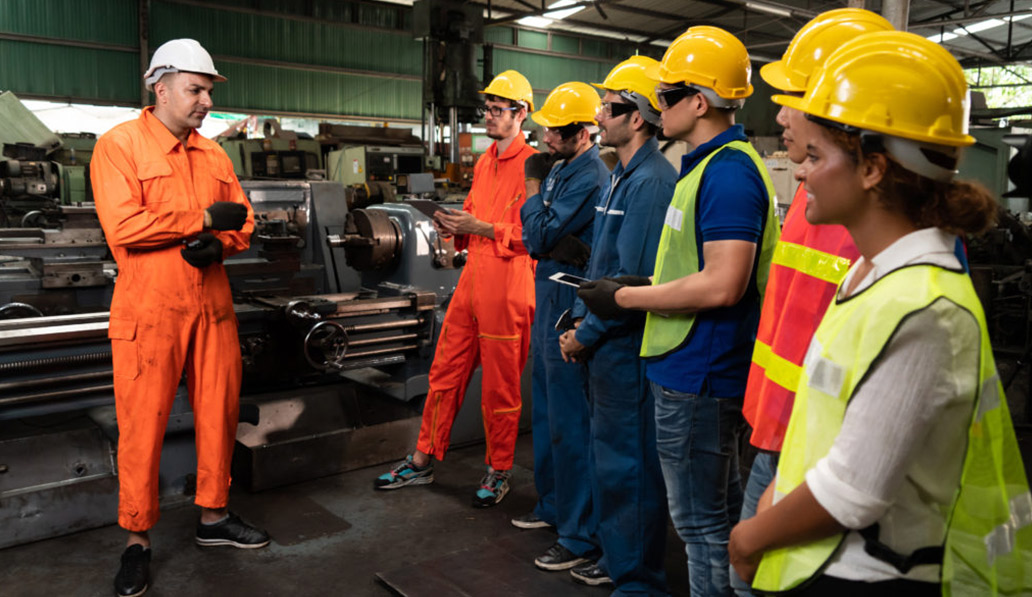Body Copy
Different Management levels of an organization have one objective among many- to make sure their colleagues and teammates on-site consider and abide by safety measures while performing any job tasks. A lot of times, foreseeable and preventable incidents that occur in the work place causing danger to property, life, and limb. Thus, ensuring a safe workplace, imparting knowledge about the safety norms to the workers, developing a positive culture, and making behavioural changes are among the many steps taken to keep the workplace risk-free.
The operators working on machinery or equipment which produce goods and provide services. The role of this group is crucial, but they can be exposed to potentially hazardous conditions- both during production and in the time of rest breaks. Operators should be compliant while performing their tasks, understand potential hazards at their workplace, know the procedures for the safe operation of equipment, and other systems, and use their personal protective devices or equipments as prescribed.
Talking about the safety protocols taken by different management levels of an organization; there are 3 levels of management and their safety protocols vary based on their roles:
- The Company (Upper Management): Should set roles, responsibilities, expectations, and enforce safety policies that are a part of the Organization.
- The Mid-Management team: Should train the managers regarding the norms about safety, and keep track of their activities.
- Frontline Supervisors: Should implement a work culture that establishes the safety protocols for themselves and their peers using various tools like checklists, SOPS, frequent reviews, etc.
Risks when safety measures are not implemented
“Risk management” system is useful to organizations and enables them to consider the potential business impact of foreseeable events like:
- Formulating and carrying out risk elimination or controls.
- Improving corporate governance and achieving the business objective in a targeted way.
- Retaining or improving shareholder confidence.
In India, an estimated 82% of workplaces do not comply with EHS norms, according to a cross-sector survey by research and consulting firm Kaybase. Thus, when an unfortunate accident occurs, there are two types of losses that an organization may face:
Direct Cost – The measurable cost arising directly from the accident
Examples of Direct Costs
- Fines from criminal court
- Medical treatment
- Worker sick pay
- Repair to, or replacement of, damaged equipment & building
- Lost or damaged product
- Lost production time whilst dealing with the injury
- Overtime to make up for the loss.
Indirect Cost – Those arising indirectly as a consequence of the event. Indirect cost is often difficult to quantify precisely and may be hard to identify. In certain circumstances, they may be extremely excessive.
Example of Indirect Cost
- Loss of Staff Morale.
- Loss of staff productive duties to investigate the said incident, prepare the report, undertake hospital visitations, and provide comfort to the relatives.
- Compliance with an enforcement notice served.
- Cost of recruiting & training temporary or replacement labour.
- Loss of goodwill of customers following production delays.
- Damage to public image and the business reputation.
- Damage to industrial relations and perhaps leading to industrial action. (e.g., strike)
Safety Measures to Incorporate
It is the responsibility of the Company and/or Organization to protect and safeguard their teammates from any unfortunate incidents. The safety protocols/procedures are an integral part of any Manufacturing or Warehousing facility. To stress their importance to the maximum, these protocols are integrated during the training period of any new employee. One must have the technical knowledge about the equipment and must learn the usage of the same. These protocols ensure the well-being of the employees which plays an integral part in the success of the Company.
Following are some of the protocols that need to be followed to safeguard the employees from hindrance:
- Employees should be trained about personal hygiene irrespective of the department that they belong to.
- Wear shoes that provide traction on slippery surfaces like metal grates or wet floors.
- Inculcate the habit to wear factory-appropriate apparel to stay protected from any sharp edges or harmful chemicals that could injure the skin.
- Stay alert by avoiding usage of cell phones or any other distractions while walking about in the Warehouse or any other active units.
- Development of Comprehensive Safety Programs, acting in accordance with the guidelines provided, maintaining safety in the work areas, and training the employees on the workplace hazards.
- Implement emergency protocols for any accidents or incidents that may occur on-site.
- Prescribe and provide Personal Protective Equipment (PPE) appropriate to the nature of the unit as well as the activites that are being performed by the workman.
- Considering weather conditions at the time of operations undertaken.
- Creating a system and a work environment where employees feel encouraged to identify and report potential safety problems and hazards.
The responsibility for safety lies with different levels of the organization. Management should lay down policies and procedures that are followed by employees, contractors, suppliers, etc. Employees need to take care of their own safety and that of others who work alongside them. Safety measures should be taken into consideration to avoid any disaster that could lead to injuries, accidents, and fatalities if not managed accordingly.
It is important to maintain safety protocols at facilities. Failing to do so may pose a threat to life and the Company. A lot of instances where the Company failing to inculcate the safety procedures incur heavy losses with regards to the respect they earned. It is also one of the measures to take that shows accountability, responsibility, and care for your teammates.

